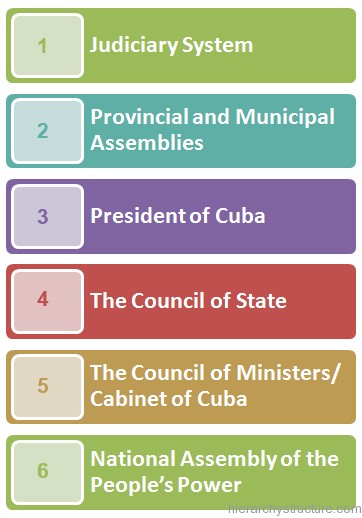Cuba is an island country in the Caribbean. The governing party in Cuba is the Communist Party of Cuba. The executive power in Cuba is exercised by the Council of State and the Council of Ministers. And, the legislative power is exercised by the National Assembly of People’s power. The National Assembly has a total of 614 members, which are elected every five years. In the following paragraphs, we will discuss the Cuban political hierarchy in more detail :

- Judiciary System
- Provincial and Municipal Assemblies
- President of Cuba
- The Council of State
- The Council of Ministers/ Cabinet of Cuba
- National Assembly of the People’s Power
National Assembly of the People’s Power
The National assembly is a legislative authority. It holds two regular sessions in a year. The deputies are elected for five years and from among them, the President, Vice President, Secretary and the 31 members of the Council of State are elected. The National Assembly has various departments that over see the work of the Commissions, Judicial affairs, Administration and International Relations. The Assembly also has the power to amend the Constitution and to approve various plans for the Cuban social and economic development of the nation.
The Council of Ministers/ Cabinet of Cuba
This is the highest ranking executive body of the Cuban political hierarchy. The council constitutes the government of the nation. The Council of Ministers is comprised of the President, First Vice President, seven Vice Presidents of the Council of State, Secretary of the Executive Committee and the various heads of the national ministries.
The function of the Council of Ministers is to implement the various policy agreements set forth by the National Assembly of People’s power. The Council also develops various plans for the social and economical development of the nation. The Council is also responsible for maintaining the international relations with other nations.
The Council of State
The Council of State is another part of the government of Cuba. The council is comprised of thirty one members and the members are elected by the National Assembly of People’s Power. The members of the Council of State consist of a President, a Secretary, a First Vice President, five Vice Presidents and twenty seven additional members.
President of Cuba
The President is the head of the state of Cuba. The different responsibilities of the President are to organize the sessions of the Council of State and the Council of Ministers, assume all the duties as assigned by the Constitution and assuming the supreme command of all the armed institutions.
Provincial and Municipal Assemblies
Cuba is divided into 15 provinces, a special municipality under the assistance of the central government and 169 municipalities of the respective provinces. The Assemblies of representatives of People’s Power are at the top positions at the provincial and municipal levels.
Judiciary System
Judicial power is exhibited by the People’s Supreme Court, which is elected by the National Assembly. The People’s Supreme Court is comprised of a President, a Vice President and provincial judges. This branch deals with the enforecement of legal system of the country. The hierarchy of courts comprises the judial system in Cuba.
Know More about Zimbabwe Political Hierarchy Click Here
